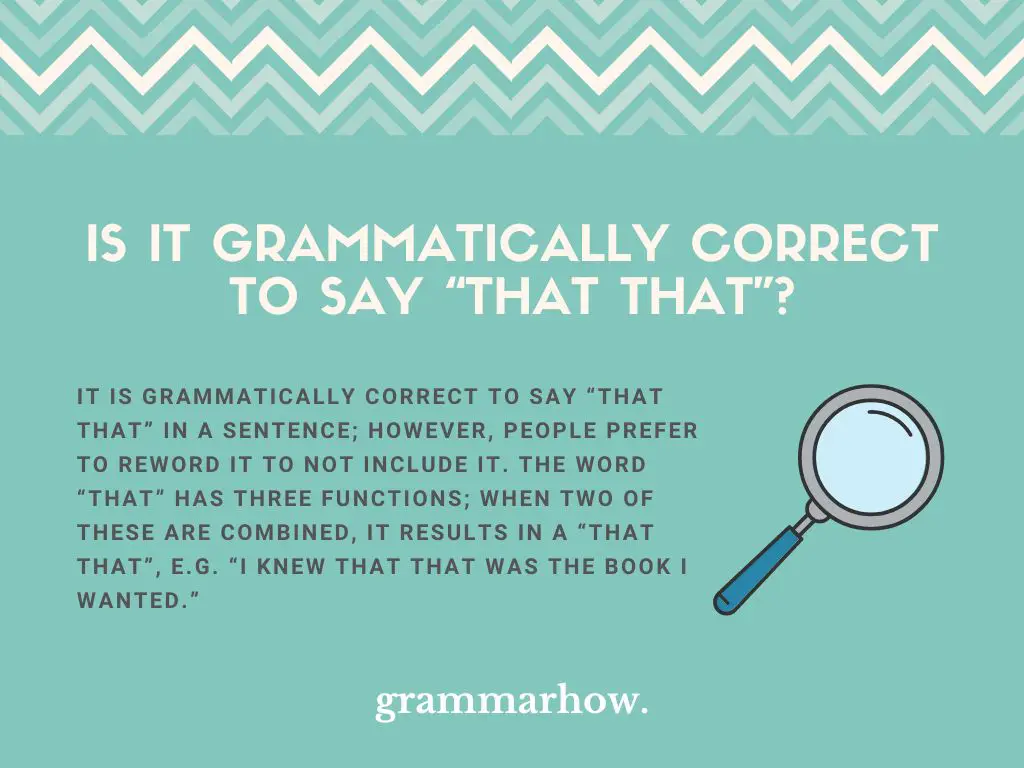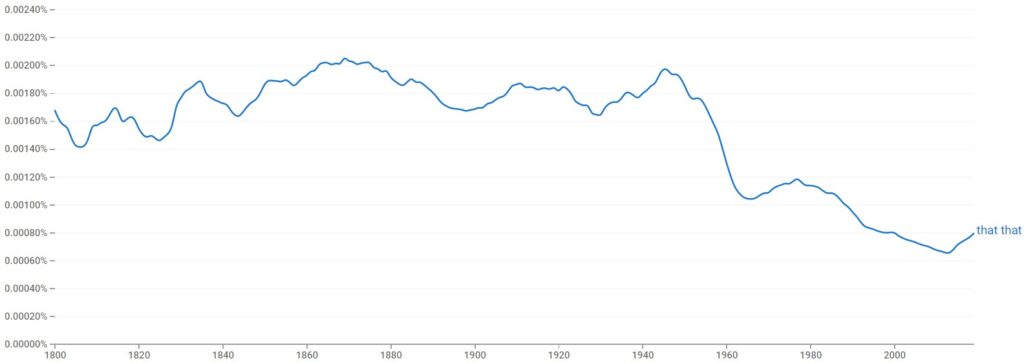To learners of English, the term “that that” may look very strange, and many would assume it is incorrect. This page looks at whether this is the case and explains whether “that that” is correct or not, and if so, how it is used in a sentence.
Is It Grammatically Correct to Say “that that”?
It is grammatically correct to say “that that” in a sentence; however, people prefer to reword it to not include it. The word “that” has three functions; when two of these are combined, it results in a “that that”, e.g. “I knew that that was the book I wanted.”

The three functions of the word “that” are as follows:
- As part of a subordinating clause – Eg. I knew that she wasn’t going to come.
- As a demonstrative pronoun – Eg. That is the one I wanted
- As an adjective – Eg. That book wasn’t the one I wanted.
When you combine number 1 with either number 2 or number 3, it results in a “that that” because you are essentially saying:
- I knew that that book was the one I wanted.
- I knew that (the fact) that (the book) was the one I wanted.
Many people use this structure and don’t give it a second thought, while others would change the sentence structure to avoid using a double “that.”
Here are some examples of how it could be changed:
- I heard that that was the day I was supposed to go to the meeting.
- I heard that Tuesday was the day I was supposed to go to the meeting.
- She said that that guy sitting over there was the one who had asked her out.
- She said that the guy sitting over there was the one who had asked her out.
- I already told you that that cake was for tonight’s party. You shouldn’t have eaten it.
- I already told you that the cake you ate was for tonight’s party. You shouldn’t have eaten it.
Is There a Comma Between “that that”?
There is no comma between the phrase “that that”, and it should be written together with no punctuation.
As shown in the examples, there is no need for a pause here because we need to know what the first “that” refers to, and it needs to be in the same clause as the second “that.”
Here are some examples that demonstrate this:
- He said that that was the game he wanted, so I don’t know why he didn’t like it.
- He said that, that was the game he wanted, so I don’t know why he didn’t like it. – INCORRECT
- She told me that that day had been a terrible day for her.
- She told me that, that day had been a terrible day for her. – INCORRECT
- We were told that that old rusty looking bus was our transport to the event.
- We were told that, that old rusty looking bus was our transport to the event. – INCORRECT
Is Using “that that” in a Sentence Proper?
Using “that that” in a sentence is proper and correct. Some people restructure the sentence to avoid using “that that” because they feel it is confusing for the reader; however, others think the meaning is evident and understandable.
It is even acceptable to sometimes have more than two “thats” in a row, as shown in the sentence below.
The Google Ngram shows us that “that that” has always been a relatively popular structure in English.

Admittedly, it has reduced in frequency somewhat since the 1960s, but nonetheless, it is still used frequently in written English.
How to Use “that that” in a Sentence
As described, the word “that” can basically have three functions, which are:
- As part of a subordinating clause – Eg. I knew that he wasn’t going to be happy
- As a demonstrative pronoun – Eg. That is the man I saw running down the street yesterday.
- As an adjective – Eg. That house is my dream house.
Combining two of these uses in the same sentence often results in a double “that.”
As shown in these examples:
- She told him that that plan was the one she favoured the most.
- He said that that day had been a complete disaster
- We all thought that that speech he gave was compelling.
- We all know that that was not your true intention
Alternatives to Using “that that”
Many alternatives can replace the words “that that” in a sentence. However, exactly which one to use is difficult to specify because there are so many ways in which you could restructure the sentence, and the word “that” can represent so many things that there is not a simple replacement for it.
Sometimes it is appropriate to replace a “that” with a pronoun, other times, it is better to use an article like “the.”
The following sentences show how the examples from the above sections can be changed to avoid using “that that.”
- She told him that she favoured a specific plan
- He said that her day had been a complete disaster.
- We all thought that the speech he gave was compelling.
- We all know that you had a different intention.
- We were told that the old rusty looking bus was our transport to the event.
- He said he wanted that game, so I don’t know why he didn’t like it.
Final Thoughts
Whilst the term “that that” is perfectly acceptable and frequent, many people still try to avoid using “that that” and instead prefer to substitute it for a pronoun or another article such as “the.” However, “that that” is correct and acceptable in written and spoken English.

Martin holds a Master’s degree in Finance and International Business. He has six years of experience in professional communication with clients, executives, and colleagues. Furthermore, he has teaching experience from Aarhus University. Martin has been featured as an expert in communication and teaching on Forbes and Shopify. Read more about Martin here.
